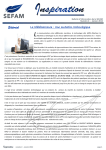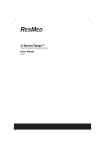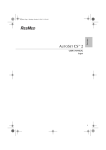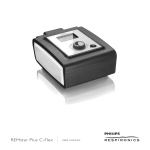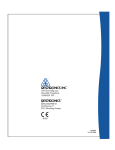Download BPS C-100 CPAP User`s guide
Transcript
USER’S GUIDE Table Of Contents Package Contents Accessories: Sold Separately Product Specifications Intended Use Compatibility ResMed Device Warning Battery Pack Run Times Power Backup Usage Getting Started Turning the Battery Pack On/Off Initial Battery Pack Usage Using the Battery Pack Inside the Carrying Case Control Board Identification The Power Meter Charging the Battery Pack with AC Power Charging the Battery Pack in a Foreign Country Charging the Battery Pack in a Vehicle Powering Your PAP Device Introduction Connector Tips Respironics Devices ResMed S9 Series Devices ResMed S8 Series Devices Fisher & Paykel Devices DeVilbiss Devices Powering Other Devices Accessories 150W Sine Wave Power Inverter 24V Power Converter Auto Charge DC Cable Battery Pack Care Instructions Safety Warnings Disclaimer Disposal of Lithium-Ion Batteries 2 2 3 4 4 4 5 6 6 6 6 7 7 8 8 9-11 12 12-13 14 15 16 17 18 19 20-21 22 22 23 24 24 24 1 Package Contents The C-100 Battery Pack comes with the items listed below. If you are missing any of these items, please contact the company from whom you purchased the Battery Pack. CARRYING CASE BATTERY PACK(S) CONNECTOR TIPS Battery Pack is sold in a single or dual battery configuration package. AC POWER SUPPLY DC POWER PIGTAIL CORD DC INPUT CORD Accessories: Sold Separately The items listed below are accessories to the C-100 Battery Pack and are not included with the Battery Pack. 24V POWER CONVERTER For use with ResMed S9 devices only. 2 150W MODIFIED SINE WAVE INVERTER AUTO CHARGE DC CABLE Product Specifications DIMENSIONS Size: 7.5” x 4.25” x 0.75” (L x W x H) Weight: 1.6 lbs ELECTRICAL Cell Type: Industrial grade rechargeable lithium-ion Capacity: 100 Wh Output Voltage Range: 9 - 12.6 V Output Current Range: 0 - 4.5 A (8A maximum) Power Gauge: Four stage LED display SAFETY FEATURES Protective Circuit Board (PCB) provides internal protection against thermal runaway (overheating), over charging and discharging, over voltage, over current, and short circuiting. Aluminum alloy scratch resistant shell provides maximum durability. RECHARGE TIME 4-5 hours (per Battery Pack when fully discharged) LIFE SPAN Under normal conditions the average life span of the Battery Pack is generally around 400-500 charge/discharge cycles. The amount of charge the Battery Pack will hold will gradually decrease due to usage and aging. This gradual decrease in charge capacity is true for all rechargeable lithium-ion batteries. See page 23 for more information. WARRANTY The C-100 Battery Pack, components and accessories are under warranty for manufacturing and quality defects for one (1) year. 3 Intended Use The C-100 Battery Pack is intended to provide external battery power to PAP (positive airway pressure) devices. The Battery Pack may also be used to power other small electronic devices such as smartphones, iPods, laptops, and iPads (use of a sine wave power inverter may be required). See page 19 for more information. Please note that use of the C-100 Battery Pack with a device that requires higher amperage requirements (over 8A) may cause the internal circuitry of the Battery Pack to shut off to protect from overrun. Compatibility The C-100 Battery Pack is compatible with most makes and models of PAP devices; however, some devices will require the use of a power converter or power inverter in conjunction with the Battery Pack. The components included with the Battery Pack kit may not be compatible with your PAP device as some manufacturers require the use of a specific DC cable with built-in fuses or other special connection types. When in doubt, please contact the manufacturer of your device. ResMed Device Warning If you are using any device manufactured by ResMed you must use either a power converter or power inverter to complete the connection between the device and the C-100 Battery Pack as newer ResMed devices operate from a 24V direct current and the input plugs on older ResMed devices run opposite polarity from other manufacturer devices. DO NOT connect the Battery Pack directly to any ResMed model device as doing so will damage the ResMed device. See pages 15-16 for connection instructions. 4 Battery Pack Run Times Multiple factors will affect how long the Battery Pack will power a PAP device, including, but not limited to device type (CPAP, BiLevel, AutoPAP, etc.), pressure setting, altitude, humidifier usage, and if a power inverter or power converter is required in conjunction with the Battery Pack. BiLevel and AutoPAP/APAP devices will generally have lower run times as the pressure setting is not constant and changes throughout the night requiring more power to operate the device. IMPORTANT NOTES ON HUMIDIFIER USAGE The use of heated humidification or heated tubing will significantly reduce expected run times and could prevent the Battery Pack from being able to power the PAP device. To obtain optimal Battery Pack performance we recommend you forgo the use of heated humidification. Using cool or “passover” humidification will not reduce expected run times. AVERAGE RUN TIMES Run times listed below are based on Respironics System One and ResMed S9 Series CPAP devices with no heated humidification or heated tubing. RESPIRONICS AND OTHER 12V DEVICES Single Battery Configuration: 1-3 nights Dual Battery Configuration: 3-5 nights RESMED AND OTHER 24V DEVICES Use of a power converter or power inverter in conjunction with the Battery Pack is required for ResMed and other 24V devices. Single Battery Configuration with Power Inverter: 1 night Single Battery Configuration with Power Converter: 2 nights Dual Battery Configuration with Power Inverter: 2 nights Dual Battery Configuration with Power Converter: 4 nights 5 Power Backup Usage Standard smart chargers keep the Battery Pack topped off and ready to go as an emergency power backup during power outages. If a power outage is immenint or probable, you may connect the PAP device to the Battery Pack and plug the Battery Pack into a wall outlet. In the event power is lost the Battery Pack will automatically begin powering the device. Do not consistently use the Battery Pack as a power backup option as this will reduce its overall life as the Battery Pack will continue to charge and recharge (charge cycles). Only use the Battery Pack in this manner when a power outage is probable or imminent. Getting Started TURNING THE BATTERY PACK ON/OFF The Battery Pack turns on or off automatically when a device is plugged into or disconnected from it. If the Battery Pack stops functioning, plug the AC power supply into a wall outlet and then into the Battery Pack to reset the internal circuitry. INITIAL BATTERY PACK USAGE Before using your Battery Pack for the first time be sure to charge it fully using AC power (a wall outlet). During the initial charge, the Battery Pack may indicate that charging is complete after just 10 or 15 minutes as the Battery Pack is already charged before it leaves the factory. USING THE BATTERY PACK INSIDE THE CARRYING CASE The Battery Pack carrying case is designed with a clear access window which allows the Battery Pack(s) to be used and/or charged while still inside of the carrying case. Simply place the Battery Pack in the carrying case with the control board facing toward the clear access window and pull open the flap to insert the appropriate connection cord into the Battery Pack. 6 Getting Started CONTROL BOARD IDENTIFICATION The control board includes the DC in and DC out jacks, charge lights and the power meter, which indicates the remaining power level. E F G A B D A DC In Jack D DC Out Jack G Power Meter C B Power Meter Button E Charging Light C Full Charged Light F On Light On Light (F) will be green when a device is plugged into the DC Out Jack (D) of the Battery Pack. Charging Light (E) will be red when the Battery Pack is being charged. Full Charged Light (C) will be green when the Battery Pack has completed charging. THE POWER METER The LED display power meter indicates the remaining power level of the Battery Pack. The power meter may be activated after the first time the Battery Pack has been charged. Press the power meter button and the number of LED lights displayed on the power meter will show the current power level of the Battery Pack. POWER METER BUTTON 4 green lights = > 85% 3 green lights = 50-85% 2 green lights = 15-50% 1 green light = < 15% POWER METER 7 Charging the Battery Pack with AC Power Connect the AC power cord to the AC power supply. Insert the AC power supply into the DC in jack of the Battery Pack. DUAL BATTERY PACK CHARGING: Insert the AC power supply into the DC power pigtail cord. Insert the DC power pigtail cord into the DC in jacks of both Battery Packs. Plug the AC power supply into a wall outlet. When charging is complete disconnect the AC power supply from the wall outlet and the Battery Pack. Note: It is normal for the AC power supply and the Battery Pack(s) to be warm to the touch during the charging process. DC IN JACK AC POWER SUPPLY AC POWER CORD Charging the Battery Pack in a Foreign Country The AC power supply of the Battery Pack will operate on any AC current from 100 V to 240 V and 50/60 Hz without any adjustment. An international electrical adapter plug is the only additional component that is required to charge the Battery Pack in a foreign country. 8 Charging the Battery Pack in a Vehicle When an AC power source is not available the Battery Pack can be safely and efficiently recharged via the cigarette lighter/power socket of a vehicle. To recharge the Battery Pack in this manner you must use either Battery Power Solutions’ Auto Charge DC Cable or 150W Modified Sine Wave Power Inverter (or other comparable sine wave power inverter). AUTO CHARGE DC CABLE 150W POWER INVERTER Please note these components are optional accessories that are sold separately and are not included with the Battery Pack kit. See pages 20-22 for additional information on accessories. IMPORTANT CHARGING NOTES The typical recharge time when the Battery Pack is fully discharged is 4-5 hours (per battery). When charging in a vehicle the recharge time may vary depending upon the method used for recharging (auto charge DC cable or sine wave inverter) and the vehicle’s battery type. When using the auto charge DC cable to recharge the Battery Pack, the vehicle must be running during the charging process to prevent draining the vehicle’s battery and to ensure the Battery Pack receives proper voltage to successfully recharge. When using the 150W sine wave inverter to recharge the Battery Pack, the vehicle does not need to be running during the charging process as long as the cigarette lighter/power socket of the vehicle is supplying power to the Battery Pack. 9 Charging the Battery Pack in a Vehicle CHARGING USING THE AUTO CHARGE DC CABLE Locate the connector tip labeled “N” in the Battery Pack Kit. See page 13 for connector tip identification instructions. Insert the “N” connector tip into the auto charge DC cable. Insert the auto charge DC cable with “N” connector tip attached into the DC in jack of the Battery Pack. DUAL BATTERY PACK CHARGING: Insert the auto charge DC cable with the “N” connector tip attached into the DC power pigtail cord. Insert the DC power pigtail cord into the DC in jacks of both Battery Packs. Turn the vehicle on and insert the cigarette lighter plug end of the auto charge DC cable into the cigarette lighter/power socket of the vehicle to begin the charging process. The vehicle must be running during the charging process to prevent draining the vehicle’s battery and to ensure the Battery Pack receives proper voltage to successfully recharge. When the charging process is complete remove the auto charge DC cable from the cigarette lighter/power socket of the vehicle. DC IN JACK 10 AUTO CHARGE DC CABLE “N” CONNECTOR TIP Charging the Battery Pack in a Vehicle CHARGING USING THE 150W SINE WAVE POWER INVERTER Insert the AC power supply into the DC in jack of the Battery Pack. DUAL BATTERY PACK CHARGING: Insert the AC power supply into the DC power pigtail cord. Insert the DC power pigtail cord into the DC in jacks of both Battery Packs. Connect the AC power supply to the inverter by sliding open the small spring loaded tab located on the back of the inverter, which will reveal the two-prong plug port. See page 21 for inverter instructions. Insert the inverter adapter cord into the cigarette lighter/power socket of the vehicle to begin the charging process. The vehicle does not need to be running during the charging process as long as the cigarette lighter/power socket of the vehicle is supplying power to the Battery Pack. When the charging process is complete remove the inverter from the cigarette lighter/power socket of the vehicle. INVERTER ADAPTER CORD AC POWER SUPPLY DC IN JACK INVERTER 11 Powering Your PAP Device: Introduction The C-100 Battery Pack will work with most makes and models of PAP devices; however, the DC capability, voltage requirements and plug polarity of the device will determine how it connects to the Battery Pack. Some PAP devices can be connected directly to the Battery Pack via the DC power pigtail cord; while others will require the additional use of a power converter or power inverter in order to complete the connection between the Battery Pack and the PAP device. The following pages provide specific instructions for how to connect the Battery Pack to Philips Respironics, ResMed, Fisher & Paykel, and DeVilbiss PAP devices. DO NOT attempt to connect the Battery Pack to a PAP device until you have read and understand these connection instructions. Failure to do so may damage the PAP device. Powering Your PAP Device: Connector Tips The C-100 Battery Pack kit comes with several different connector tips. These tips are designed to fit many types of devices that offer DC capability. If the PAP device can be connected directly to the Battery Pack, as with Respironics and DeVilbiss PAP devices, one of the connector tips will need to be used in order to connect the PAP device to the Battery Pack. DETERMINING THE APPROPRIATE CONNECTOR TIP Begin by comparing the connector tips provided with the Battery Pack kit to the tip of the AC power supply of the PAP device. Choose the connector tip that most closely matches. Locate the DC input port on the PAP device and try to insert the chosen connector tip. The connector tip should insert easily and should not be forced into place. 12 Powering Your PAP Device: Connector Tips Make sure the connector tip sits securely in the DC input port of the PAP device. If the connector tip is loose try another one as you want to avoid using a loose connector tip if there is a better match. Once you have determined the best fitting connector tip, insert it into the DC power pigtail cord and follow the connection instructions for your specific device. PAP DC INPUT PORT CONNECTOR TIP DC POWER PIGTAIL CORD IDENTIFYING CONNECTOR TIPS Once you have determined the appropriate connector tip for your device, use one of the following methods for identifying that tip for future use: Each connector tip has a very small letter embossed on the top of the black plastic portion of the tip (this letter can be difficult to read but it is present). CONNECTOR TIP LETTER Keep the connector tip you have chosen inserted into the DC power pigtail cord. Store the connector tip in a separate place away from the other tips. 13 Powering Your PAP Device: Respironics Devices Respironics PAP devices operate from a 12V direct current and may be connected directly to the Battery Pack using the DC power pigtail cord. Insert the DC power pigtail cord into the DC out jack of the Battery. DUAL BATTERY PACK CONFIGURATION: Insert the DC power pigtail cord into the DC out jacks of both Battery Packs. Insert the appropriate connector tip into the DC power pigtail cord. See page 12-13 for connector tip instructions. Insert the DC power pigtail cord with the appropriate connector tip attached into the DC input port of the Respironics PAP device. Turn the PAP device on and it should begin functioning. PAP DC INPUT PORT DC POWER PIGTAIL CORD DC OUT JACK SINGLE BATTERY CONFIGURATION CONNECTION DUAL BATTERY CONFIGURATION CONNECTION 14 Powering Your PAP Device: ResMed S9 Devices ResMed S9 Series devices operate from a 24V direct current so the use of a power converter or sine wave power inverter is required to complete the connection between the device and the Battery Pack. DO NOT connect the Battery Pack directly to any ResMed model device. Battery Power Solutions’ 24V Power Converter was specifically designed for use with ResMed S9 Series PAP devices. Insert the 24V power converter into the DC out jack of the Battery Pack. The 24V power converter must be connected to the Battery Pack before it is connected to the ResMed S9 PAP device. DUAL BATTERY PACK CONFIGURATION: Insert the 24V power converter into the DC power pigtail cord. Insert the DC power pigtail cord into the DC out jacks of both Battery Packs. Insert the 24V power converter into the DC input port of the S9 device. Turn the PAP device on and it should begin functioning. 24V POWER CONVERTER DC OUT JACK PAP DC INPUT PORT Note: ResMed’s S9 Series DC/DC Converter or a sine wave power inverter may also be used to complete the connection between the ResMed S9 device and the Battery Pack. 15 Powering Your PAP Device: ResMed S8 Devices ResMed S8 Series PAP device input ports run opposite polarity from other manufacturers so the use of ResMed’s S8 Series DC-12 Converter or a sine wave power inverter is required to complete the connection between the device and the Battery Pack. DO NOT connect the Battery Pack directly to any ResMed model device. Insert the DC input cord into the DC out jack of the Battery Pack. DUAL BATTERY PACK CONFIGURATION: Insert the DC power pigtail cord into the DC out jacks of both Battery Packs. Insert the DC power pigtail cord into the DC input cord. Insert the ResMed DC-12 Converter into the DC input cord and then into the DC input port of the S8 PAP device. Turn the PAP device on and it should begin functioning. DC OUT JACK DC INPUT CORD RESMED S8 SERIES DC-12 CONVERTER PAP DC INPUT PORT Note: A sine wave power inverter may also be used to complete the connection between the ResMed S8 device and the Battery Pack. 16 Powering Your PAP Device: Fisher & Paykel Devices Currently Fisher & Paykel PAP devices do not have a DC capability option and therefore require the use of a sine wave power inverter to complete the connection between the PAP device and the Battery Pack. Battery Power Solutions offers an incredibly small, yet powerful 150 Watt Modified Sine Wave Power Inverter. Insert the DC input cord into the DC out jack of the Battery Pack. DUAL BATTERY PACK CONFIGURATION: Insert the DC power pigtail cord into the DC out jacks of both Battery Packs. Insert the DC power pigtail cord into the DC input cord. Insert the inverter adapter cord to the DC input cord. Connect the PAP device AC power cord to the inverter by sliding open the small spring loaded tab located on the back of the inverter, which will reveal the two-prong plug. See page 21 for inverter instructions. Turn the PAP device on and it should begin functioning. DC OUT JACK PAP AC POWER CORD DC INPUT CORD INVERTER ADAPTOR CORD BPS 150W POWER INVERTER 17 Powering Your PAP Device: DeVilbiss Devices DeVilbiss PAP devices operate from a 12V direct current and may be connected directly to the Battery Pack using the DC power pigtail cord. Insert the DC power pigtail cord into the DC out jack of the Battery. DUAL BATTERY PACK CONFIGURATION: Insert the DC power pigtail cord into the DC out jacks of both Battery Packs. Insert the appropriate connector tip into the DC power pigtail cord. See page 12-13 for connector tip selection instructions. Insert the DC power pigtail cord with the appropriate connector tip attached into the DC input port of the DeVilbiss PAP device. Turn the PAP device on and it should begin functioning. PAP DC INPUT PORT DC POWER PIGTAIL CORD DC OUT JACK 18 Powering Other Devices The C-100 Battery Pack can be used to power other small electronic devices such as smartphones, iPads, portable DVD players, and laptops. 12V DEVICES WITH DC CABLE If the electronic device operates from a 12V direct current and has a DC cable with a cigarette lighter plug you can connect the device directly to the Battery Pack using the DC input cord. DC IN JACK DC INPUT CORD DEVICE DC CABLE DEVICES WITHOUT A DC CABLE & NON 12V DEVICES If the electronic device does not have a DC cable or does not operate from a 12V direct current you will need to use a sine wave power inverter to complete the connection between the device and the Battery Pack. SINE WAVE POWER INVERTER ELECTRONIC DEVICE AC POWER SUPPLY DC INPUT CORD DC IN JACK 19 Accessories: 150W Sine Wave Power Inverter Sine wave power inverters are used to change direct current (DC) to alternating current (AC). Using a modified or pure sine wave power inverter in conjunction with the Battery Pack allows you to: Power Other Small Electronic Devices To power a small electronic device that does not have a DC cable with a cigarette lighter plug or does not operate from 12V direct current, use a power inverter to complete the connection between the device and the Battery Pack. Power Devices Without DC Capability To power a PAP device or other small electronic device that does not have DC capability, you must use a power inverter to complete the connection between the device and the Battery Pack. Charge the Battery Pack in a Vehicle As an alternative to the Auto Charge DC Cable, you may also use a power inverter in conjunction with the Battery Pack AC Power Supply to recharge the Battery Pack via the cigarette lighter/power socket of a vehicle. See page 11 for additional information. Battery Power Solutions offers an incredibly small, yet powerful 150 Watt Modified Sine Wave Power Inverter. SPECIFICATIONS Output Rated Power: 120W (continuous) - 150W (maximum) Dimensions: 5.25" x 2.75" x .5" (LxWxH) Weight: 0.5 lbs NOTE: This item is sold separately from the C-100 Battery Pack kit. 20 Accessories: 150W Sine Wave Power Inverter CONNECTING THE 150 WATT INVERTER TO THE BATTERY PACK Insert the DC input cord into the DC out jack of the Battery Pack. Connect the inverter adaptor cord to the side of the inverter. Insert the cigarette lighter plug end of the inverter adaptor cord into the DC input cord. INVERTER INVERTER ADAPTOR CORD DC INPUT CORD DC OUT JACK NOTE: It is normal for the inverter to become warm to the touch and to hear the internal fan operating when in use. CONNECTING YOUR DEVICE TO THE 150 WATT INVERTER Connect the AC power cord of your device to the inverter by sliding open the small spring loaded tab located on the back of the inverter, which will reveal the two-prong plug port. If the device has a USB cable, it can be connected to the inverter via the USB port located on the back of the inverter. USB PORT TWO-PRONG PLUG PORT SPRING LOADED TAB 21 Accessories: 24V Power Converter (for ResMed S9 devices) DC to DC power converters convert a source of direct current (DC) from one voltage to another (i.e. 12V to 24V). Power converters are generally proprietary to a specific device. Battery Power Solutions’ 24V Power Converter was specifically designed for use with ResMed S9 Series PAP devices and provides a clean, efficient conversion from 12V to 24V direct current. See page 15 for more information. SPECIFICATIONS Input: 12V / 24V Output: 24V / 3.75A Length: 4 ft (connector to connector) Weight: 0.35 lbs NOTE: This item is sold separately from the C-100 Battery Pack kit. Accessories: Auto Charge DC Cable Battery Power Solutions’ Auto Charge DC Cable allows you to safely and efficiently recharge the C-100 Battery Pack via the cigarette lighter/power socket of a vehicle. See page 10 for more information. SPECIFICATIONS Input/Ouput: 12V Length: 4 ft 5 inches (connector to connector) Weight: 0.16 lbs NOTE: This item is sold separately from the C-100 Battery Pack kit. 22 Battery Pack Care Instructions Understanding common phenomenon with rechargeable lithium-ion batteries can help you better care for your C-100 Battery Pack and answer many common questions regarding usage. Lithium-ion batteries do not suffer from the memory effects that are associated with other types of battery chemistries. This means that the C-100 Battery Pack does not need to be completely discharged before recharging. Upon initial use or after a prolonged storage period lithium-ion batteries may require 3-4 charge/discharge cycles before achieving their maximum capacity. Lithium-ion batteries will self-discharge when unused; therefore, the Battery Pack will need to be recharged after a storage period. On average the Battery Pack will discharge by 20% every 30 days. The amount of charge lithium-ion batteries will hold will gradually decrease due to usage and aging. Over time, the actual battery capacity decreases as less and less active material within each lithium-ion cell is available to electrochemically store a charge. This loss in capacity (aging) is true for all rechargeable lithium-ion batteries. It is normal for a lithium-ion battery and its AC power supply to become slightly warm to the touch during charging and discharging. BATTERY PACK STORAGE Charge the Battery Pack to 30-50% of capacity before storage. Store the Battery Pack in a dry, cool place away from extreme heat, direct sunlight and metal objects. If the Battery Pack is being stored for long periods of time we recommend charging the Battery Pack to 50% of capacity at least once every six months. 23 Safety Warnings The following safety warnings must be observed at all times: Do not drop, hit, crush, or otherwise abuse the Battery Pack as this may result in the exposure of the cell contents, which are corrosive. Do not expose the Battery Pack to rain or moisture of any type. Do not expose the Battery Pack to fire, incineration or other extreme heat. Exposure to extreme heat may result in an explosion. Do not disassemble the Battery Pack (remove the cover) or attempt to repair the Battery Pack as there are no user-serviceable parts inside. Periodically inspect connection cords, connector tips and the power supply for damage or signs of wear. Discontinue use if damaged. Disclaimer By purchasing, using or possessing any of Battery Power Solutions’ products, you are agreeing to hold harmless Battery Power Solutions, it’s subsidiaries, affiliates, owners, officers and employees from any and all claims or liability for any damage to any property or injury, illness or death of any person when such damage, injury, illness or death shall be caused in whole or in part from use of the product(s). Disposal of Lithium-Ion Batteries Lithium-ion batteries should be recycled. Some states have specific laws regarding the disposal of lithium-ion batteries. You should contact your local Government Household Hazardous Waste Agency for information on state battery disposal regulations. For information on where you can recycle your batteries at no cost, visit www.call2recycle.org or call 1-877-723-1297. 24 1-877-445-5228 [email protected] www.batterypowersolutions.net C-100 CPAP BATTERY PACK USER’S GUIDE SEPTEMBER 2014































